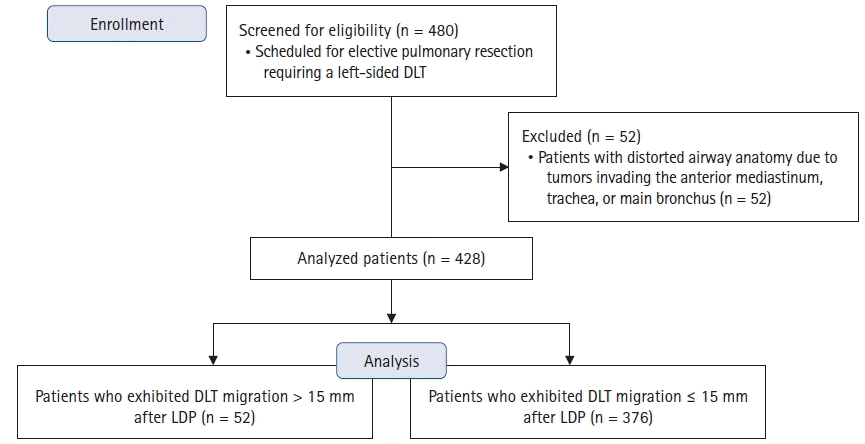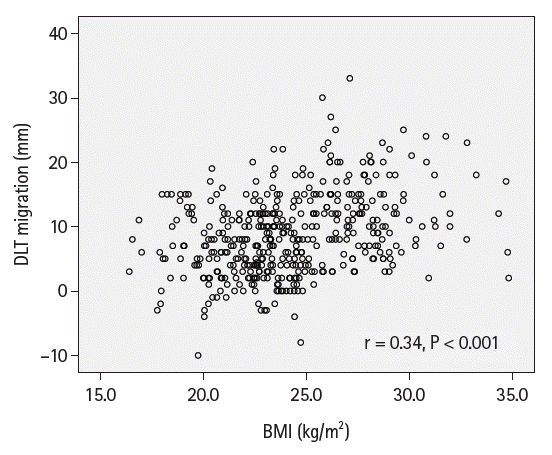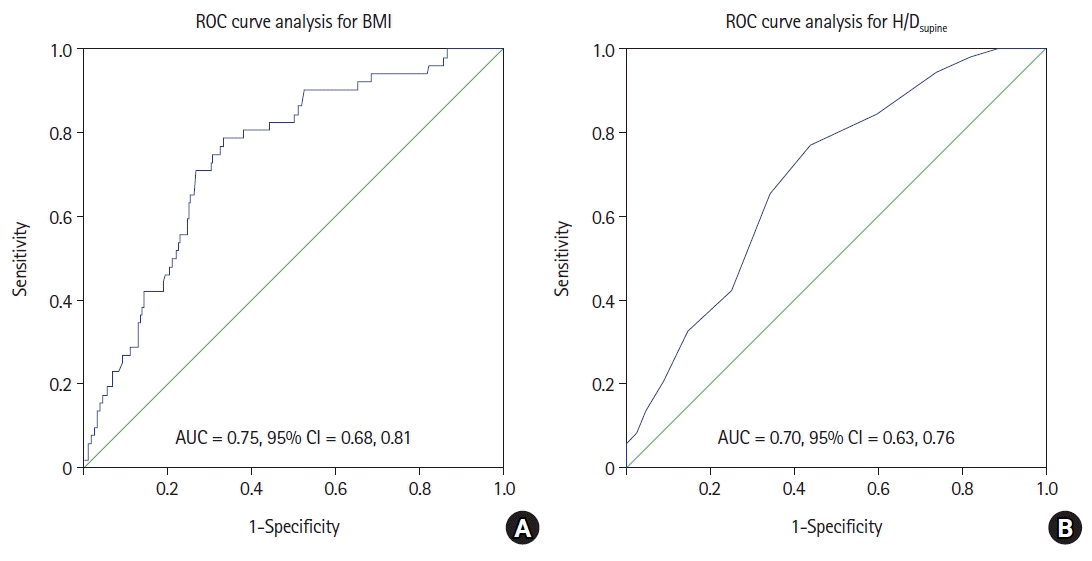1. Karzai W, Schwarzkopf K. Hypoxemia during one-lung ventilation: prediction, prevention, and treatment. Anesthesiology. 2009; 110:1402–11.
2. Klein U, Karzai W, Bloos F, Wohlfarth M, Gottschall R, Fritz H, et al. Role of fiberoptic bronchoscopy in conjunction with the use of double-lumen tubes for thoracic anesthesia: a prospective study. Anesthesiology. 1998; 88:346–50.
3. Langiano N, Fiorelli S, Deana C, Baroselli A, Bignami EG, Matellon C, et al. Airway management in anesthesia for thoracic surgery: a "real life" observational study. J Thorac Dis. 2019; 11:3257–69.
4. Inoue S, Nishimine N, Kitaguchi K, Furuya H, Taniguchi S. Double lumen tube location predicts tube malposition and hypoxaemia during one lung ventilation. Br J Anaesth. 2004; 92:195–201.
5. Gray H. Anatomy of the Human Body. 13th ed. Philadelphia: Lea & Febriger;1985.
6. Desiderio DP, Burt M, Kolker AC, Fischer ME, Reinsel R, Wilson RS. The effects of endobronchial cuff inflation on double-lumen endobronchial tube movement after lateral decubitus positioning. J Cardiothorac Vasc Anesth. 1997; 11:595–8.
7. Boriek AM, Lopez MA, Velasco C, Bakir AA, Frolov A, Wynd S, et al. Obesity modulates diaphragm curvature in subjects with and without COPD. Am J Physiol Regul Integr Comp Physiol. 2017; 313:R620–9.
8. Kim N, Byon HJ, Kim GE, Park C, Joe YE, Suh SM, et al. A randomized controlled trial comparing novel triple-cuffed double-lumen endobronchial tubes with conventional double-lumen endobronchial tubes for lung isolation. J Clin Med. 2020; 9:977.
9. Cohen E. Double-lumen tube position should be confirmed by fiberoptic bronchoscopy. Curr Opin Anaesthesiol. 2004; 17:1–6.
10. Nam GE, Kim YH, Han K, Jung JH, Rhee EJ, Lee WY. Obesity fact sheet in Korea, 2020: prevalence of obesity by obesity class from 2009 to 2018. J Obes Metab Syndr. 2021; 30:141–8.
11. de Bellis M, Accardo R, Di Maio M, La Manna C, Rossi GB, Pace MC, et al. Is flexible bronchoscopy necessary to confirm the position of double-lumen tubes before thoracic surgery? Eur J Cardiothorac Surg. 2011; 40:912–6.
12. Slinger PD. Fiberoptic bronchoscopic positioning of double-lumen tubes. J Cardiothorac Anesth. 1989; 3:486–96.
13. Gaillat F, Duponq R, Chabert L, Charvet A. Double-lumen tube intubation systematic verification with fiberoptic bronchoscopy: between what who should do and what we can do. Eur J Cardiothorac Surg. 2011; 40:917–8.
14. Benumof JL, Partridge BL, Salvatierra C, Keating J. Margin of safety in positioning modern double-lumen endotracheal tubes. Anesthesiology. 1987; 67:729–38.
15. Obesity: preventing and managing the global epidemic. Report of a WHO consultation. World Health Organ Tech Rep Ser. 2000; 894:i-xii, 1-253.
16. Lim JU, Lee JH, Kim JS, Hwang YI, Kim TH, Lim SY, et al. Comparison of World Health Organization and Asia-Pacific body mass index classifications in COPD patients. Int J Chron Obstruct Pulmon Dis. 2017; 12:2465–75.
17. Park SK, Ryoo JH, Oh CM, Choi JM, Kang JG, Lee JH, et al. Effect of overweight and obesity (defined by Asian-Specific cutoff criteria) on left ventricular diastolic function and structure in a general korean population. Circ J. 2016; 80:2489–95.
18. Pan WH, Yeh WT. How to define obesity? Evidence-based multiple action points for public awareness, screening, and treatment: an extension of Asian-Pacific recommendations. Asia Pac J Clin Nutr. 2008; 17:370–4.
19. Brodsky JB, Benumof JL, Ehrenwerth J, Ozaki GT. Depth of placement of left double-lumen endobronchial tubes. Anesth Analg. 1991; 73:570–2.
20. Parameswaran K, Todd DC, Soth M. Altered respiratory physiology in obesity. Can Respir J. 2006; 13:203–10.
21. Ezri T, Hazin V, Warters D, Szmuk P, Weinbroum AA. The endotracheal tube moves more often in obese patients undergoing laparoscopy compared with open abdominal surgery. Anesth Analg. 2003; 96:278–82.
22. Liou DZ, Berry MF. Thoracic surgery considerations in obese patients. Thorac Surg Clin. 2018; 28:27–41.
23. Cheng KS, Wu RS, Tan PP. Displacement of double-lumen tubes after patient positioning. Anesthesiology. 1998; 89:1282–3.
24. Yoon TG, Chang HW, Ryu HG, Kwon TD, Bahk JH. Use of a neck brace minimizes double-lumen tube displacement during patient positioning. Can J Anaesth. 2005; 52:413–7.
25. Seo JH, Hong DM, Lee JM, Chung EJ, Bahk JH. Double-lumen tube placement with the patient in the supine position without a headrest minimizes displacement during lateral positioning. Can J Anaesth. 2012; 59:437–41.
26. Maruyama D, Chaki T, Omote M, Hirata N, Yamauchi M, Yamakage M. Movements of the double-lumen endotracheal tube due to lateral position with head rotation and tube fixation: a Thiel-embalmed cadaver study. Surg Radiol Anat. 2015; 37:841–4.
27. Seo JH, Bae JY, Kim HJ, Hong DM, Jeon Y, Bahk JH. Misplacement of left-sided double-lumen tubes into the right mainstem bronchus: incidence, risk factors and blind repositioning techniques. BMC Anesthesiol. 2015; 15:157.
28. Brodsky JB, Shulman MS, Mark JB. Malposition of left-sided double-lumen endobronchial tubes. Anesthesiology. 1985; 62:667–9.
29. Conrardy PA, Goodman LR, Lainge F, Singer MM. Alteration of endotracheal tube position. Flexion and extension of the neck. Crit Care Med. 1976; 4:8–12.







 PDF
PDF Citation
Citation Print
Print



 XML Download
XML Download